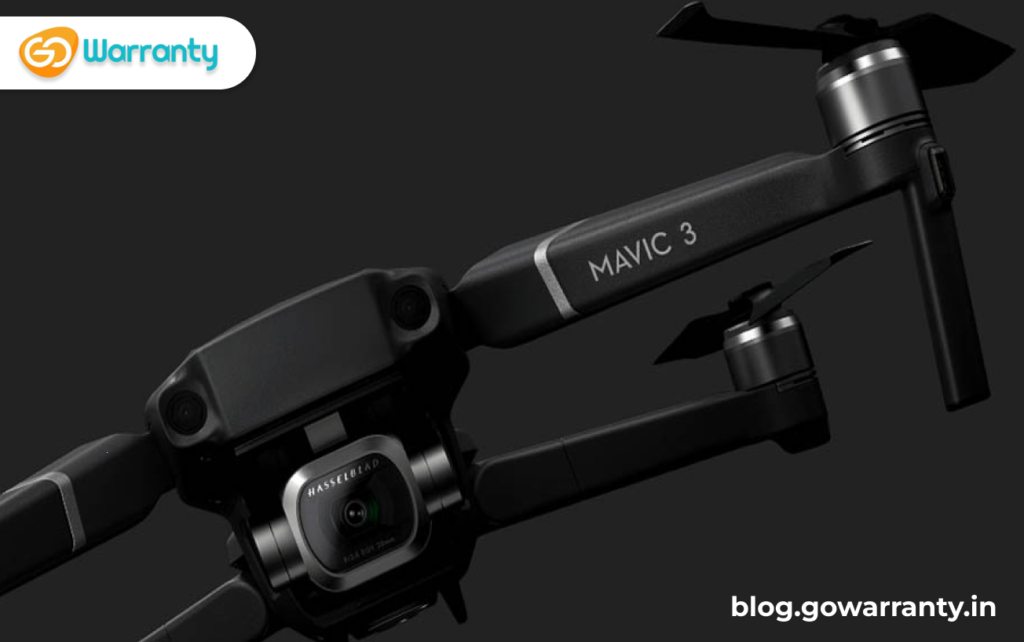Following the announcement of the Inspire 3, It has introduced its new DJI Mavic 3 Pro drones, which include a unique Tri-camera system. The Mavic 3 Pro is the most recent addition to the extremely popular Mavic series, and it appears to add a slew of new features and functionality. It is certain to be a popular drone because it bridges the gap between some of DJI’s less expensive options and the Inspire 3.
DJI first announced the Mavic 2 Pro and Mavic 2 Zoom in 2018. They unveiled the Mavic 3 as well as Mavic 3 Cine, the third iteration of the popular Mavic series, three years later in 2021. They had two cameras and two sensors, and they could record up to 5.1K video at 50fps and 4K video at up to 120fps. Both drones had a flight time of 47 minutes.
Tri-Camera System
The Mavic 3 Pro employs a novel Tri-Camera System. In a triangular configuration, there are three different camera and sensor combinations. The idea is to increase the drone’s flexibility and allow users to capture a variety of shots at different focal lengths. The three cameras are housed in the same 3-axis gimble, regardless of their independence.
The primary sensor/camera combination is a 20MP 4/3 CMOS sensor paired with a Hasselblad camera with a wide angle lens. It can capture up to 5.1K resolution. A 1/2-inch 12MP CMOS camera with a 166mm 7x telephoto zoom is used in the second camera/sensor combination. This will allow you to take fairly tight shots.

A 1/1.3-inch CMOS sensor with a 49MP 70mm medium telephoto zoom is the third combination.
The larger image sensor (4/3′′) is said to provide a higher dynamic range and more effective noise suppression in low-light environments for the Mavic 3 Pro and Mavic 3 Pro Cine. Both drones are claimed to have a dynamic range of 12.8 stops. The previous Mavic 3 and Mavic 3 Cine used a 4/3 CMOS sensor as well as a Hasselblad camera. Both drones had a 28x hybrid zoom camera with a 1/2′′ sensor, though the zoom lens quality left a lot to be desired.
The Mavic 3 Pro Cine has all of the same features as the Mavic 3 Pro, except it can capture in Mavic 3 Pro Cine supports Apple ProRes 422 HQ, Apple ProRes 422, as well as Apple ProRes 422 LT encoding at a maximum data rate of 3772 Mbps. When using any of the three cameras, you can capture in all of these ProRes formats.
Recording Capabilities
Both the DJI Mavic 3 Pro and Mavic 3 Pro Cine can record 5.1K video at up to 50fps and 4K DCI video at up to 120fps. They can also record 1080p at up to 200fps, but only in H.264/H.264. The Mavic 3 Pro can record in 10-bit H.264 or H.265 formats. The Mavic 3 Pro Cine supports H.264/H.265 and ProRes 422 HQ recording. When recording 4K 120fps in ProRes 422 HQ, the data rate is a whopping 3772 Mbps. The maximum bitrate when recording H.264 is 200Mbps, while the maximum bitrate when recording H.265 is 140Mbps. In comparison, the Mavic 2 Pro had a maximum data rate of 100 Mbps.
Enhanced Autofocus with extended flight times
DJI has included what they call “new Vision Detection Auto Focus Technology.” This enables the Mavic 3 Pro and the Hasselblad camera to capture distance data and optimise focusing speeds by utilising multiple vision sensors on board. The Mavic 3 Pro and Mavic 3 Pro Cine have a maximum flight time of up to 43 minutes (without wind and at 15.5mph / 25kph). This is slightly less than the Mavic 3 and Mavic 3 Cine’s 46 minutes.
Battery
DJI developed motors and propellers that are more energy efficient. The battery has a capacity of 5000 mAh and is identical to those found in the Mavic 3 and Mavic 3 Cine. What you should know is that the available multi-battery charger can only charge three batteries, not four like the one that came with the Mavic 2 Pro.
Size, Weight and Speed
The Mavic 3 Pro weighs 958g, while the DJI Mavic 3 Pro Cine weighs 963g. The Mavic 3 weighs 895g / 1.97 lb, while the Mavic 3 Cine weighs 899g / 1.98 lb.
The dimensions of the Mavic 3 Pro and the Mavic 3 Pro Cine are as follows:
- Folded (without propellers): 231.1×98×95.4 mm (L×W×H)
- Unfolded (without propellers): 347.5×290.8×107.7 mm (L×W×H)
The maximum speed of the Mavic 3 as well as Mavic 3 Cine is 21 m/s (S mode), which is slightly faster than the Mavic 2 Pro’s 20 m/s (S mode), but the same as the Mavic 3 and Mavic 3 Cine. The Mavic 3 Pro and Mavic 3 Pro Cine have the following maximum ascent speeds: 6 m/s in P mode, 8 m/s in S mode
The maximum descent speed (P mode) is also 6 m/s. This means that the Mavic 3 Pro as well as Mavic 3 Pro Cine are no faster at descending and ascending than their predecessors.
DJI O3+ and Cellular Transmission Dongle
The DJI O3+ transmission system is said to deliver stable, smooth as well as clear video transmission even in difficult conditions, such as environments with high signal interference. With a maximum control range of 9.3 miles / 14.96km, O3+ allows the Mavic 3 Pro to fly further while transmitting signals with greater stability and less video lag.
Verdict
The DJI Mavic 3 Pro and Mavic 3 Pro Cine are priced in line with their predecessors. This is encouraging, especially given that the Inspire 3 costs significantly more than the Inspire 2. If you can afford the extra INR 1,46,999, the Mavic 3 Pro Cine is arguably the more interesting of the two options.
Of course, pricing is important, and when there is no direct competition, you can charge a higher price for your products. Depending on your point of view, the Mavic 3 Pro drones could be considered either expensive or very affordable.

